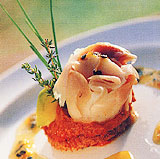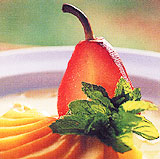Menu Planning for Beginners
What is a menu?
Essentially, a menu is a list of dishes and beverages which has prices attached.
Why do we need a menu?
For the customer:
The menu is an information sheet for the customer. It tells him what is on offer
in the way of food and beverages, at what price in what portion size. It also
creates a "mood" or ambiance and expectations in the mind of the customer.
For the knowledgable manager:
The menu allows the manger to plan his / her whole business.
The menu tells the manger, what type of business he runs.
For instance:
-
a la Carte or
-
Table b Hotel
An a la carte menu differs from a Table d Hotel menu
Types of Menus:
The a la Carte menu:
An a la Carte menu has a wide choice of dishes in each category, larger portions
and the dishes are more costly (due to the fact that the portions are bigger
and the wide choice may cause a possibility of having to keep items for a
fairly long time in storage).
This menu is also normally more expensive due to the fact, that the manager
cannot always exactly forecast the amount of business and how well a dish will
be liked.
Additional to this is, that the dishes are more difficult to prepare and this
means a higher qualified person / cook or chef is needed which demands a higher
salary.
In an a la Carte menu, each dish is individually priced. This
allows the customer to make a choice according to his means without having to
loose “face” in front of his peers which may have more money.
He simply pretends that he has very little appetite.
The Table d Hotel menu:
This is a “set menu.” That means, it is pre-determined by the operator.
This type of menu has little or no choice and is entirely made up by the
operator.
However, it has only one price for the whole menu,
which will usually be at least a starter, a main course with starch and 2
vegetables and a dessert with coffee. The portions are much smaller that in an
a la Carte menu, due to the fact, that a person’s stomach can only hold a
limited amount of food. Smaller portions means smaller cost, little choice
means smaller cost and very good control over the portion size; plus, a set
menu is usually prepared for a known amount of people. This is exactly, why a
set menu is ideal for functions ( e.g. Christenings, birthdays, weddings,
wakes) or for a “captive” amount of customers, such as in institutions (Old Age
Homes, Schools, Universities, travel by air, bus, boat or train, Hospitals, the
army and not to forget Jail populations).
A “Cycle” menu:
This is a type of set menu which keeps repeating within a
certain amount of time. This is usually for a period of 3 month which equals a
season such as spring, summer, fall
or winter.
By staying within these seasons, we can take advantage of the fact, that
anything which grows within this season will be at its best quality, freely
available, and therefore at it’s cheapest!
Another advantage of the cycle menu is the fact that repetition improves
performance by the workers and this improves productivity and is ideal for
training situations.
However, there must never be a situation, that the repetition
is so predictable, that people look at the calendar and say ” It is Monday, so
we must be getting lasagne”.
How does a menu allow the manager to plan his whole buiness?
A menu consists of a number of dishes.
All these dishes are prepared by means of a recipe.
The recipe tells the manager:
-
What He / She has to order
-
How much He / She has to order, at what quanlity, cut and price.
The recipe has a method attached to it, which tells the
manager:
-
How difficult is it to prepare, which tells him
-
How skillful his staff has to be in order to prepare and serve the dish
The method also tells the manager what type of machinery and
equipment he has to have to produce the menu.
The ingredients and type of dishes as well as the names of the dishes will tell
the manager what type of business he is running (a take-away has a different
type and standard of menu from a 3 or 5 Star Restaurant)
By getting quotes for equipment, he does not only get information about the
price of the equipment, but also about the size, which helps him to
calculate the amount of production space which he will need.
The Price of the ingredients, labour cost and size and price of his premises
will give him a pretty good idea of the kind of budget he will need to run his
business.
It is exactly for this kind of reason, that the saying “THE MENU IS YOUR
BUSINESS” is entirely true.
|




